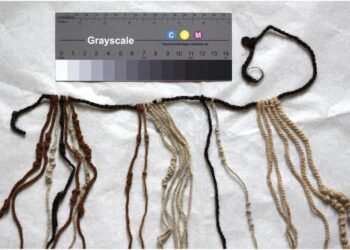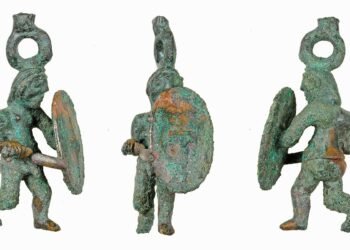During a routine metal detector survey on the Danish island of Zealand near the city of Ringsted, amateur archaeologists Finn Ibsen and Lars Danielsen uncovered a small bronze fitting depicting Alexander the Great.

The fitting, measuring just 26-28 millimeters in diameter, showcases the iconic face of Alexander the Great, also known as Alexander III of Macedon. This depiction, believed to date back to around 200 CE during the Roman Iron Age, reflects Alexander’s divine lineage to Zeus-Ammon, symbolized by the ram’s horns adorning his head. Such depictions were common during the period, often found on ornamental attachments for war shields.
The discovery, made near the site of Zealand’s Sjællands Landsting, an assembly of early Germanic societies, highlights the significance of Ringsted in Denmark’s cultural and historical landscape. Experts from the Moesgaard Museum have dated the fitting to the Roman period, suggesting a timeframe around 200 CE. The depiction of Alexander with ram’s horns symbolizes his divine lineage to Zeus-Ammon. Such depictions were common during the period, often found on ornamental attachments for war shields.
Freerk Oldenburger, an archaeologist at Museum Vestsjælland, said, “It’s fantastic. Up here in Scandinavia, you don’t usually find anything about Alexander the Great, and when you stand with such a small portrait in your hands, you get excited.”
Alexander the Great, who reigned from 356 to 323 BCE, remains one of history’s most renowned military leaders, known for his vast empire spanning from Greece to India. His legacy endured for centuries, influencing Roman emperors like Caracalla, who considered himself a reincarnation of the Macedonian king.
During Caracalla’s era, a pivotal clash occurred at Illerup Ådal, Denmark, where shields adorned with portraits resembling Alexander’s were ritually deposited alongside other armaments. The uncanny resemblance between this recently unearthed fitting and its counterpart at Illerup Ådal prompts inquiries into Denmark’s historical and cultural ties of the time. Furthermore, it sparks debate over the fitting’s purpose—whether it embellished a shield or served as a symbol of strength and divine safeguarding on military attire.
Museum Vestsjælland plans to display the artifact, ensuring that both the public and scholars can appreciate its historical significance and the story of interconnectedness it represents.























